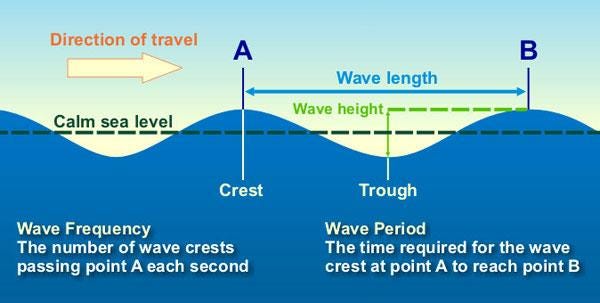My books are based on or around the water. That means waves. Sea conditions often affect the plots, especially chase scenes. The prevalent wind direction for the Florida Keys is southeast. That’s good for fishing, but kind of boring in a story, so I tend to mix things up a bit. In Wood’s Chase, for example, I used a north wind for the second half of the story to throw another wrench in the works for my characters to deal with.
I’m a boater and a paddler. Waves are important to both and I have several apps that I check more than I ought to. Powerboating is fairly straightforward. Downwind paddling or downwinders, are point-to-point paddles (one way requiring a shuttle ride) paddles with the wind and waves at the paddlers’ back are not.
Wind speed and wave height are directly related. Here are my rules:
Boating (dependent on passengers)
Under 10 knots I’ll go anywhere
10 - 12 knots okay for bottom fishing (anchoring)
12-15 knots okay for offshore (trolling)
15 - 20 knots - seek protected water
over 20 - that’s what bars are made for
Paddling
Under 10 knots - flat water paddle
10 - 12 knots - find protected water
12-15 knots - stay home. Usually a suckfest.
15 - 25 knots - downwinder time
Over 25 knots - downwinder if conditions are favorable
Boating in the Keys allows for many options. The reef and offshore are great if it’s fairly calm, though I’ve fished tournaments in gale-force winds. The backcountry is great for windy days. Wind direction matters, but is not critical.
Paddling takes a little more research. Flatwater paddling is fairly straightforward. Downwinders take some thought. Yesterday is a good example. We did a 12 mile run from Indian Rocks Beach to the Dunedin Causeway. The wind shifted from SW to SE over the course of the run, but the swell leftover from the SW wind remained the dominant factor. Knowing some history is critical to a safe run. In this case, the larger swell, which runs toward the beach resulting in large breaking waves can be dangerous. The tendency is to try and catch the bigger waves; the smart and faster move is to ride with the wind and catch the little waves. Clocking winds (when they change direction) are a major factor in my decisions.
All waves are not created equal either, though, with the exception of boat wakes, they are created in the same way. In most cases wind causes waves. Storms cause larger waves. Waves in different waters are also different. The Pacific is known for its large swells that originate in Alaska and can roll through to Hawaii. Waves in the Atlantic vary depending on latitude and proximity to the Gulf Stream. In South Florida and the Keys, we rarely get the large swells that Hawaii experiences regularly.
Ocean swells and wind waves are also different. A two-foot chop driven by a 12-knot wind can be more uncomfortable than a twenty-foot ocean swell. The reason is the wave frequency or period. Short period waves are close together often with only a few seconds between them (2’ @ 4 seconds). Big swells can have periods in excess of 20 seconds. In South Florida and the Keys, it is all about the wind and period.
Water depth also has a noticeable effect on waves. The science is way over my head, but there is a good rule of thumb. When a wave’s height reaches 3/4 of the bottom depth it will break. That is the reason waves break off beaches, reefs, and shoals.




